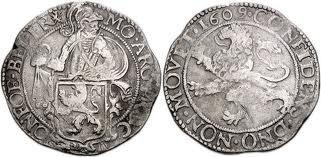Neil S Berman - Expert Numismatist & Silver Coin Dealer
Silver Coins Trade through History
Lion Dollar Silver Coins
 The Dutch Kruisdaalder or Cross Daalder (dollar) depicted the Spanish Cross of Burgundy, which was originally a Spanish naval ensign since 1506. The design was prevalent on all coins in the Dutch provinces of the Spanish Empire. This coin was replaced by a new dollar after King Phillip II, a Catholic, renounced the throne in the rebellious provinces. The rijksdaalder, or "national dollar" was a Dutch coin first issued by the Republic of the Seven United Netherlands in the late 16th century during the Protestant Dutch revolt. The new coin no longer depicted the Spanish Cross, but a lion, thus its Dutch name leeuwendaalder or Lion dollar.
The Dutch Kruisdaalder or Cross Daalder (dollar) depicted the Spanish Cross of Burgundy, which was originally a Spanish naval ensign since 1506. The design was prevalent on all coins in the Dutch provinces of the Spanish Empire. This coin was replaced by a new dollar after King Phillip II, a Catholic, renounced the throne in the rebellious provinces. The rijksdaalder, or "national dollar" was a Dutch coin first issued by the Republic of the Seven United Netherlands in the late 16th century during the Protestant Dutch revolt. The new coin no longer depicted the Spanish Cross, but a lion, thus its Dutch name leeuwendaalder or Lion dollar.
This coin was produced from 1575 in six of the seven revolting Dutch provinces and in several Dutch cities. The leeuwendaalder was authorized to contain 427.16 grains of .750 fine silver. It was lighter than the large denomination ducatoon and the rijksdaalder coins then in circulation. It was more advantageous for a Dutch merchant to pay a foreign debt in leeuwendaalders rather than in more costly rijksdaalders. Thus, the leeuwendaalder became the coin of choice for foreign trade. The coin was popular in the Middle East, the colonies in the Far East and in New World.
As the Netherlands broke away from the Spanish Empire and became a great naval and trading power in its own right, the daalder and rijksdaalder circulated alongside the Gulden and Spanish Dollars from the New World. Featuring an armored half bust of the William I, the Protestant Prince of Orange, rijksdaalders were minted to the Saxon reichsthaler weight standard of 448 grains of .885 fine silver to compete with other European coins. The provinces of Friesland, Gelderland, Holland, Kampen, Overijssel, Utrecht, West Friesland, Zeeland and Zwolle minted rijksdaalders until the end of the 17th century. With the disappearance of the original armored half bust design, silver ducats and later 2½ guilders were all called rijksdaalders.
From the Dutch colony of New Nederland or New York, the lion dollar spread to all thirteen colonies. The term was later applied to the Spanish Pillar Dollars used in the Spanish American colonies, which were also widely used in the British North American colonies by the time of the American Revolution, and adopted as the name of the US monetary unit in the late 18th century. The Dutch dollar was imitated in several German and Italian cities, and gave their name to the currencies of both Romania and Moldova, the leu, which literally translates to "lion" In the Netherlands, the name rijksdaalder lived on until the gulden was replaced by the euro in 2002. We buy and sell most collectable coins including Thalers and Lion Dollars.